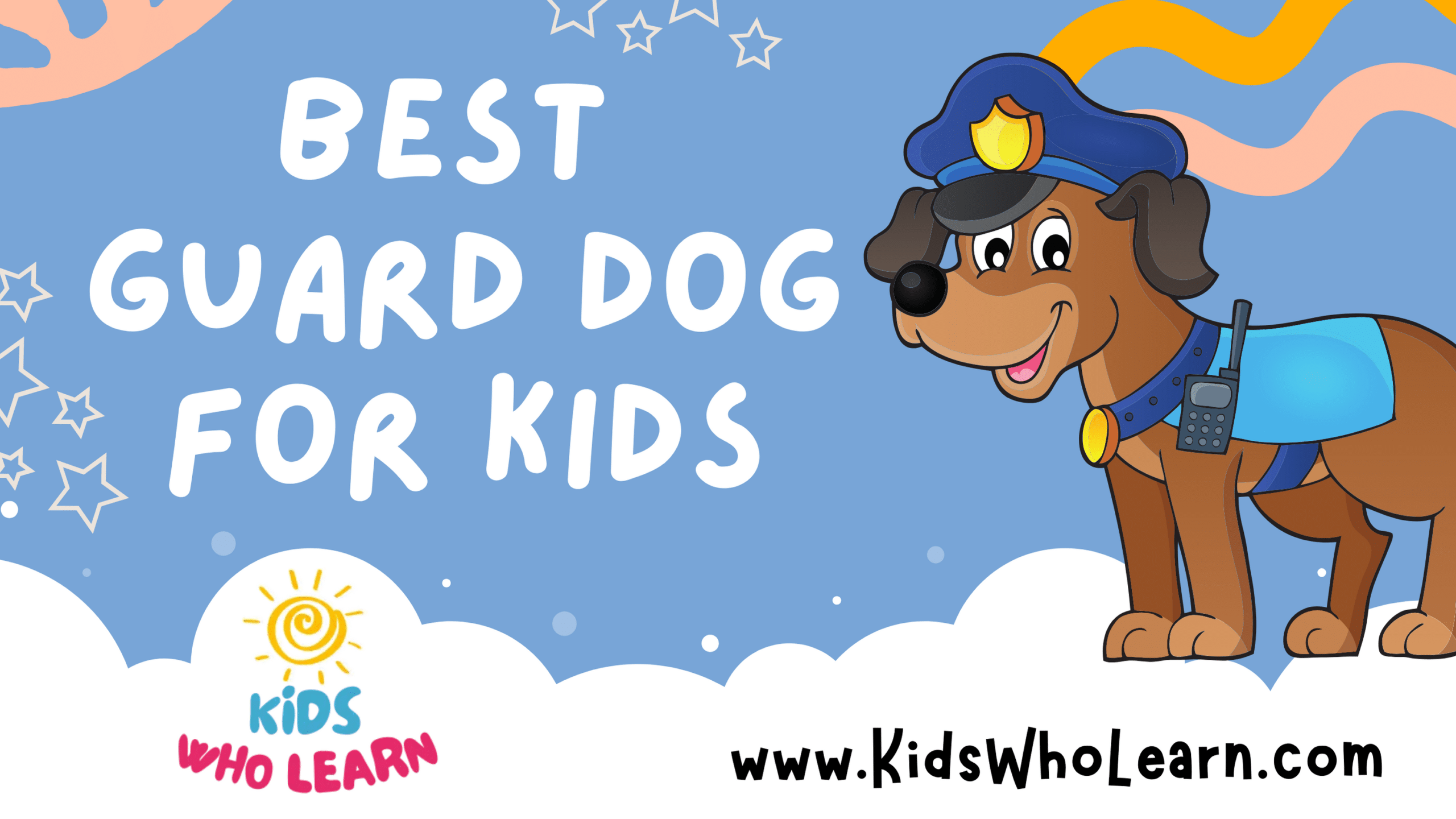When searching for the best guard dog for a family with children, it’s essential to strike a balance between protective instincts and a gentle temperament. A guard dog not only serves as a deterrent to potential intruders but also acts as a loyal companion to its family. We must consider breeds known for their ability to interact safely with children while also possessing the natural alertness and courage required to protect their home.
To ensure a harmonious relationship between our guard dog and young family members, it’s important to focus on proper training and socialization from an early age. A well-trained guard dog knows when to be vigilant and when to be calm and friendly. Additionally, maintaining the health and wellbeing of our guard dog ensures they are at their best both physically and mentally to carry out their protective role effectively.
Key Takeaways
- A suitable guard dog should exhibit a protective nature while being gentle with children.
- Training and socialization are crucial for a guard dog to behave appropriately around the family.
- Regular health maintenance is necessary to keep the guard dog in optimal condition for its duties.
Understanding Guard Dogs
When selecting a guard dog for your home, it’s crucial to consider specific traits that enhance their protective capabilities, differentiate between guard dogs and watchdogs, and to understand the family dynamics with such breeds.
Traits of an Effective Guard Dog
We know that a guard dog isn’t just any pet – they play a critical role in the security of our home. An effective guard dog exhibits a balanced temperament, is obedient, and has a natural protective instinct. Here’s what we should look for:
- Loyalty and Obedience: A guard dog should be devoted to its family and able to follow commands promptly.
- Physical Attributes: A robust and intimidating presence can ward off intruders.
- Sensory Perception: Keen senses of hearing and sight are pivotal. Guard dogs must detect unusual activities before they escalate.
- Protective Instinct: They should be naturally protective without being overly aggressive toward family members or guests.
Guard Dog or Watchdog?
The terms ‘guard dog’ and ‘watchdog’ are often mistakenly used interchangeably, but they represent distinct roles:
- Watchdogs alert us to potential danger through barking. They are vigilant but not necessarily physically imposing.
- Guard dogs provide an active layer of protection. Not only do they alert us, but they are also willing and able to confront a threat.
Understanding this difference helps us decide what level of security suits our home the best.
Guard Dogs and Family Dynamics
Integrating a guard dog into a family requires patience and training. Here’s how these dogs fit into the family setting:
- Training: Early socialization and consistent training are vital for guard dogs to understand their role in the family hierarchy and to act appropriately.
- Child-Friendly Breeds: Some guardian breeds are better suited for families with children due to their gentle nature around kids.
- Territorial Behavior: Guard dogs can be highly territorial, ensuring the security of our home, but may require monitoring to maintain a harmonious environment for visitors.
We must consider these factors seriously to ensure that the guard dog provides protection while also fitting seamlessly into our family life.
Choosing the Right Breed
When selecting the ideal guard dog for kids, it’s crucial to consider breed characteristics that align with a family environment and the physicality to ensure protection.
Large and Powerful Breeds
Among the large and powerful breeds, the German Shepherd stands out due to its intelligence and loyalty, making it a top choice for families. Rottweilers and Bullmastiffs also make excellent guards due to their strength and protective instincts.
Herding and Working Breeds
Belgian Malinois and Australian Shepherds are highly trainable and known for their working ability. Boxers and Dobermans are alert and develop strong bonds with family members, which translates into their protective behavior.
Breeds with Gentle Characteristics
Despite their size, breeds like the Saint Bernard and Bernese Mountain Dog are known for their gentle demeanor, particularly important when around children. Golden Retrievers are not traditional guard dogs but can be protective while being exceptionally patient and friendly with kids.
Hypoallergenic Guard Dog Options
For families with allergy concerns, consider the Giant Schnauzers or Airedale Terriers. Both breeds are known for their courage and loyalty while sporting a hypoallergenic coat. The Puli and Bergamasco Sheepdog also offer hypoallergenic qualities with a natural instinct to guard and protect.
Training and Socialization
Proper training and socialization are essential for guard dogs to ensure they are safe and reliable around kids. We aim to focus on exercises that promote both physical and mental health, and techniques that build positive interactions with children and other pets.
Importance of Early Training
Initiating training in the early stages of a puppy’s life sets the groundwork for obedience and good behavior. Early training harnesses a dog’s natural alertness and desire to please, making them highly trainable. We emphasize the need for patience and consistent positive reinforcement to establish desired behaviors.
Exercises for Physical and Mental Health
A regular routine of exercises not only maintains physical health but also provides mental stimulation. Here’s how we balance the two:
- Physical Exercise:
- Running: At least 30 minutes twice a day.
- Obstacle Courses: Tailored to challenge agility and endurance.
- Mental Stimulation:
- Puzzle Toys: Engages problem-solving abilities.
- Obedience Training: Reinforces commands and enhances concentration.
Both aspects are key in curtailing potential aggressive tendencies by keeping the dog engaged and focused.
Socializing with Children and Other Pets
Dogs that are well-socialized with children and other pets from a young age are less likely to show aggression and more likely to exhibit protective behavior. For this:
- Introduce your dog to diverse groups of people and pets in controlled settings.
- Monitor and guide interactions to ensure they remain positive.
- Reward calm and friendly behavior to reinforce good social habits.
Advanced Training Techniques
For those seeking to further their dog’s abilities:
- Remote Commands: Challenge your dog’s obedience at a distance.
- Simulated Guard Scenarios: Train for specific protective behaviors in a safe environment.
It’s crucial to consult with professional trainers when attempting advanced techniques to ensure safety and efficacy.
Health and Maintenance
Proper health and maintenance are vital to ensure that a guard dog is at their peak both physically and mentally, capable of effectively protecting and interacting with kids. We focus on specific areas of care to ensure their well-being.
Diet and Nutrition
Choosing the right diet for a guard dog is crucial. We recommend:
- High-quality dog food: Either commercially produced or home-prepared with your veterinarian’s approval and supervision.
- Balanced diet: Should include a proper balance of proteins, carbohydrates, fats, vitamins, and minerals.
- Age-appropriate feeding: Puppies, adults, and senior dogs have different nutritional requirements.
Grooming Needs
The grooming needs vary based on the breed:
- Short-haired dogs: Typically require less grooming; a weekly brushing is sufficient.
- For hypoallergenic breeds: Regular grooming is essential to maintain coat health and reduce allergenic dander.
Exercise Requirements
Guard dogs require regular exercise to maintain their health and prevent behavioral issues.
- Daily exercise: At least 30 to 60 minutes each day, such as walks, runs, or playtime.
- Mental stimulation: Puzzles, training exercises or obstacle courses to keep their mind sharp.
Regular Health Check-Ups
Scheduled veterinary visits are non-negotiable for preventative care:
- Vaccinations and Parasite Control: Follow the vet’s recommended schedule.
- Dental care: Regular dental check-ups and cleanings as recommended by your veterinarian.
Integrating a Guard Dog into the Home
When we bring a protective dog into our home, especially when children are involved, it’s essential to create a balance between loyalty and gentleness. We must ensure the dog is alert yet has a gentle demeanor towards the family, particularly around kids. The key is training and environment—setting clear boundaries and understanding the dog’s behavior are paramount.
Establishing Boundaries
Creating boundaries is the first step in integrating a guard dog into our home. A well-defined space for our dog helps establish a sense of order and security. We use clear and consistent commands to define where the dog is allowed to go and when it needs to stay put, ensuring children and the dog can coexist safely.
- Designated Areas: We choose specific areas for the dog to eat, sleep, and play.
- Prohibited Spaces: Certain areas should be off-limits, like children’s rooms when unsupervised.
- Routine: Dogs, including a Giant Schnauzer or a Great Pyrenees, thrive on routine. Regular feeding, walking, and playtimes help enforce these boundaries.
Creating a Safe Environment
A safe environment is crucial, not just for our children but also for the dog. We take steps to remove any potential hazards and create a comfortable area where the dog can relax and not feel constantly on alert.
- Remove Hazards: We check for and remove items that can be harmful to the dog or that the dog could turn into hazards.
- Comfort Zone: We provide a personal space with a bed and toys where the dog can retreat to when it needs solitude.
- Interaction Zones: Places in our home are designated for positive interactions between the dog and family members, reinforcing the dog’s role as a protective companion.
Understanding Dog Behavior
Grasping the nuances of our dog’s behavior allows us to prevent misunderstandings and cultivate a relationship based on mutual respect. Guard dogs like the Great Pyrenees are naturally wary but with patience and correct training, they become discerning protectors.
- Body Language: We observe and learn our dog’s body language to understand its feelings and reactions.
- Consistent Training: Consistency is key in our training, helping our dog understand what is expected of it.
- Family Dynamics: We teach the dog how to interact with all family members, ensuring it recognizes them as part of its pack to protect.
Preventing Aggressive Tendencies
It’s our responsibility to prevent any aggressive tendencies in our protective dog and ensure its behavior remains under control. The term ‘nanny dog’ is often used to describe family guard dogs, like the Giant Schnauzer, due to their protective yet gentle nature.
- Socialization: Early and regular socialization helps the dog become comfortable with different scenarios and people.
- Positive Reinforcement: We use rewards to encourage good behavior, showing the dog that being calm and gentle is beneficial.
- Job to Do: Giving our guard dog a job or tasks can prevent boredom and reduce the likelihood of undesirable behaviors.
Historical and Cultural Significance
Guard dogs have held significant roles throughout history, from protecting livestock to serving alongside law enforcement. We will explore the pivotal breeds that shaped this legacy and the modern context of guard dogs in society.
Famous Guard Dog Breeds in History
Historically, several breeds have stood out for their courage and loyalty. The German Shepherd, originating from Germany as the name suggests, was bred for its intelligence and capability, serving not only as a fearless protector for German tax collectors but also gaining prominence as a military and police dog. The Boxer, also from Germany, was valued for its strength and protective instincts.
Moving eastward, the Akita, known as a Japanese mountain dog, displayed fierce loyalty and was often associated with Japanese nobility, reflecting status and guardianship. The vast Himalayas introduced us to the Tibetan Mastiff, an imposing breed used to guard sheep from predators.
In the colder climates of Russia, the Caucasian Shepherd, often referred to as the Russian bear dog, was a formidable guardian against predators and intruders due to its sheer size and fearless nature.
Guard Dogs in Modern Society
In today’s world, guard dogs continue to hold a place of importance. The American Kennel Club recognizes breeds like the Doberman Pinscher and Cane Corso for their vigilant presence and innate ability to protect. These breeds have been refined over the years to emphasize traits like bravery and capability in police work.
The Belgian Malinois is another exemplary breed, favored for police work and often seen alongside law enforcement due to its versatility and keen protective instincts. In regions like Switzerland, traditionally bred guard dogs such as the Greater Swiss Mountain Dog still serve to protect and manage farmland.
Across various continents and cultures, guard dogs have evolved to meet the specific needs of their environment while maintaining the underlying traits of loyalty and fearlessness that make them so invaluable to us.
Legal Considerations and Responsibilities
We must be mindful that owning a guard dog comes with specific legal and ethical responsibilities. Our awareness and compliance with local laws can prevent unfortunate incidents and ensure that our dogs serve as reliable protectors rather than liabilities.
Liability Laws for Guard Dogs
Dog owners are usually liable for their pets’ actions, especially in cases where the dog has shown a propensity for aggression. The specifics can vary by jurisdiction, but generally speaking:
- Strict Liability: Some areas impose strict liability, meaning that we, as dog owners, are responsible for almost any harm our guard dogs might cause, irrespective of whether we were negligent.
- One-Bite Rule: Other regions may operate under a one-bite rule, indicating that liability is established if we knew our dog had the tendency to be aggressive or had bitten someone before.
| Aggression Level | Owner’s Liability | Preventative Measures Required |
|---|---|---|
| Fearless, Watchful Dog | Potentially High | Strong security measures |
| Previously Aggressive Dog | High | Adequate warning signs |
| Protective, Alert Dog | Moderate to High | Proper fencing and restraint |
In addition, we should know that certain breeds may be subject to specific regulations or bans.
Ethical Considerations
When discussing guard dogs and ethics, it’s essential to differentiate between protective and aggressive behavior:
- Protective Behavior: We should train our dogs to be protective in a way that reduces the risk of unnecessary harm. They should be alert and watchful, reacting appropriately to actual threats.
- Aggressive Behavior: We must avoid encouraging overly aggressive behavior in dogs. Our role is to ensure they do not pose an undue threat to others, balancing their courage and fearless nature with control and restraint.
To uphold these ethical standards, we ought to:
- Implement Regular Training to help nurture a balanced behavior.
- Create Clear Boundaries so our dogs understand their limits.
- Promote a Positive Environment that does not instigate unnecessary aggression.
Ensuring our guard dogs are obedient and manageable relies on our commitment to responsible ownership and ongoing education.
Community and Support
When we consider the best guard dogs for kids, proper training and community support play vital roles. Expert-led guard dog training programs can ensure these dogs are safe and reliable around children. Additionally, local breed clubs offer valuable resources to understand and meet the needs of a specific breed, enhancing their capabilities as protective companions.
Guard Dog Training Programs
Guard dog training programs are essential for developing a dog’s natural protective instincts while maintaining a friendly nature around children. These programs often include:
- American Kennel Club (AKC) sanctioned training: Specializes in courses for obedience, socialization, and dog sports.
- Compliance with standards of training: Ensures consistency in commands and behaviors, creating predictability in the dog’s actions.
We emphasize the importance of ongoing training and socialization to foster a safe and balanced environment for both the guard dog and the children.
Local Breed Clubs and Societies
Getting involved with local breed clubs and societies can be beneficial for guard dog owners. These groups often provide:
- Breed-specific guidance: Tailored strategies that suit your guard dog’s unique breed characteristics.
- Networking opportunities: Connect with other owners to share experiences and training tips.
- Events and dog sport involvement: Participation in dog sports can enhance a dog’s skills and social behavior.
We recommend engaging with these communities to support your guard dog’s development and ensure a harmonious relationship within the family.
Frequently Asked Questions
In this section, we address common concerns regarding the selection of guard dogs that are suitable for families with children. We focus on breeds that balance ease of care, hypoallergenic qualities, and suitable temperament for guardianship and compatibility with kids.
What breeds are considered the most low-maintenance guard dogs?
Low-maintenance guard dog breeds that offer protection without requiring extensive grooming or exercise include the Boxer and the Bullmastiff. These dogs are known for their loyalty and require moderate exercise and grooming.
Which hypoallergenic dogs are best suited for protection duties?
The Giant Schnauzer and the Standard Poodle are hypoallergenic breeds that are also keen and protective. They’re an excellent choice for families that are concerned about allergies while needing a dependable guard dog.
What are the top small to medium-sized breeds ideal for guarding and safe around kids?
The Beagle and the Cocker Spaniel are small to medium-sized breeds known for their watchfulness and friendly nature with children. They can make good guard dogs for families while being manageable in size.
Which dog breeds are recommended for first-time owners looking for a protective pet?
We recommend the Labrador Retriever and the Golden Retriever for first-time dog owners. Both are known for their trainability and protective instincts, making them suitable as both family pets and guard dogs.
What are the easiest dog breeds to train for home security and personal protection?
German Shepherds and Belgian Malinois are among the easiest dogs to train for security and protection roles due to their intelligence and eagerness to please. They require consistent training but respond very well.
Among the guard dog breeds, which are known to be the gentlest with children?
The Newfoundland and the Bernese Mountain Dog are large breeds renowned for their gentle disposition with children. While they make effective guard dogs, their temperament makes them especially safe around younger family members.















